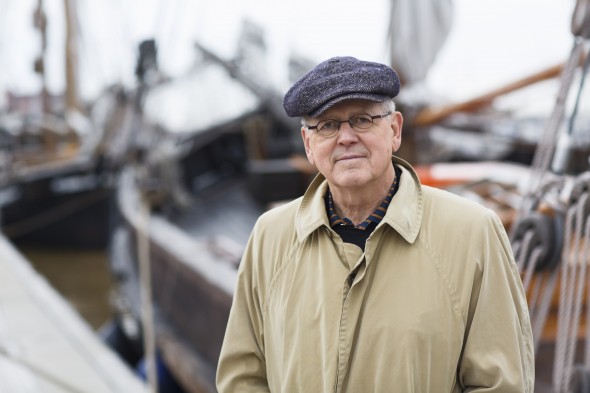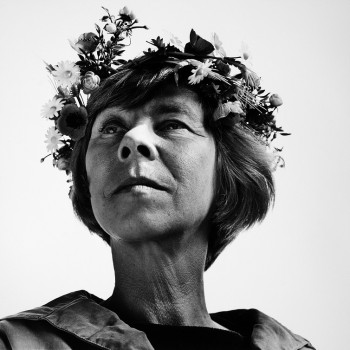Archive for June, 1981
The engineer’s story
Issue 2/1981 | Archives online, Fiction, Prose
A short story from Maailman kivisin paikka (‘The stoniest place in the world’, 1980). Introduction by Pekka Tarkka
Coffee was going to be served down by the river. The engineer took my elbow and led me across his paved courtyard and over his lawn; we settled ourselves down in cane chairs under the trees. Mirja came out of the house with a tray of coffee and coffee-cups, a loaf of sweet bread, already cut, some marble cake and some biscuits. The engineer said nothing. My eye wandered over the ample weeping birches by the river, the mist creeping up in the cool of the evening and shifting in the cross-pull of the breeze and the current, and I watched Mirja moving under the trees back to the house and then down again to the riverbank.
As we sipped our coffee we spoke about chance, and the part it plays in life, about my husband – for I was able to speak about him now: enough time had gone by. The engineer eased himself into a comfortable position, gave me a quick look and then launched off into an account of his own, about his trip abroad:
I spotted the news item as I was going through the morning paper on the plane. I sat more or less speechless all of the first leg, listening to Kirsti and her husband confabulating. I didn’t say anything during the stop-over in Copenhagen, either, where they wanted to get some schnapps and, of course, some chocolate ‘if Kirsti would really like some’. We came rushing back into the plane just as the last English, German and Danish announcements were coming over, and then we sat waiting for the take-off. That was delayed too because of a check-up (not announced), and then we were off again for Zurich, me without a word and they whispering together. Then it was the bus as far as the terminal, and after that a taxi to the hotel. Quite clearly Kirsti hadn’t heard a thing about it yet, and probably hadn’t had much contact with Erkki for quite some time, her new husband even less. More…
Locomotive
Issue 2/1981 | Archives online, Fiction, Prose
A short story from Dockskåpet (‘The doll’s house’). Introduction and translation by W. Glyn Jones
What I am about to write might perhaps seem exaggerated, but the most important element in what I have to tell is really my overriding desire for accuracy and attention to detail. In actual fact, I am not telling a story, I am writing an account. I am known for my accuracy and precision. And what I am trying to say is intended for myself: I want to get certain things into perspective.
It is hard to write; I don’t know where to begin. Perhaps a few facts first. Well, I am a specialist in technical drawings and have been employed by Finnish Railways all my life. I am a meticulous and able draughtsman; in addition to that I have for many years worked as a secretary; I shall return to this later. To a very great extent my story is concerned with locomotives; I am consciously using this slightly antiquated word locomotive instead of loco, for I have a penchant for beautiful and perhaps somewhat antediluvian words. Of course, I often draw detailed sketches of this particular kind of engine as part of my everyday work, and when I am so engaged I feel no more than a quiet pride in my work, but in the evenings when I have gone home to my flat I draw engines in motion and in particular the locomotive. It is a game, a hobby, which must not be associated with ambition. During recent years I have drawn and coloured a whole series of plates, and I think that I might be able to produce a book of them some time. But I am not ready yet, not by a long way. When I retire I shall devote all my time to the locomotive, or rather to the idea of the locomotive. At the moment I am forced to write, every day; I must be explicit. The pictures are not sufficient. More…
The Monkey
Issue 2/1981 | Archives online, Fiction, Prose
A short story from Dockskåpet (‘The doll’s house’). Introduction and translation by W. Glyn Jones
The newspaper came at five o’clock, as it did every morning. He lit the bedside lamp and put on his slippers. Very slowly he shuffled across the smooth concrete floor, threading his way as usual between the modeling stands; the shadows they cast were black and cave-like. He had polished the floor since last making some plaster casts. There was a wind blowing, and in the light from the street lamp outside the studio the shadows were swaying to and fro, forced away from each other and then brought together again: it was like walking through a moonlit forest in a gale. He liked it. The monkey had wakened up in its cage and was hanging on to the bars, squealing plaintively. “Monk-monk,” said the sculptor as he went out into the hall to fetch his newspaper. On his way back he opened the door of the cage, and the monkey scrambled on to his shoulder and held on tight. She was cold. He put her collar on and fastened the lead to his wrist. She was a quite ordinary guenon from Tangier that someone had bought cheap and sold at a large profit: she got pneumonia now and then and had to be given penicillin. The local children made jerseys for her. He went back to bed and opened his newspaper. The monkey lay still, warming herself with her arms around his neck. Before long she sat down in front of him with her beautiful hands clasped across her stomach; she fixed her eyes on his. Her narrow, grey face betrayed a patience that was sad and unchanging. “Go on – stare, you confouded orangoutang,” the sculptor said and went on reading. When he reached the second or third page the monkey would suddenly and with lightning precision jump through the newspaper, but always through the pages he was finished with. It was a ritual act. The newspaper is torn apart, the monkey shrieks in a triumph and lies down to sleep. It can give you some relief to read about all the worthless nonsense that goes on in the world every morning at five o’clock and then to have it confirmed that it is worthless nonsense when the whole lot is made unreadable by a great hole being made through it. She helped him to get rid of it. More…


